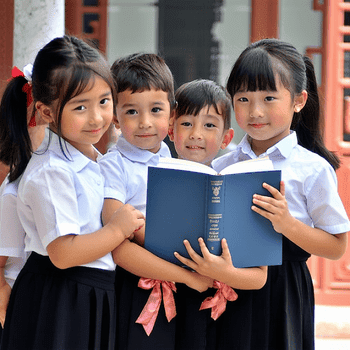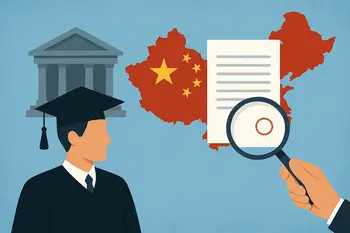
Understanding China’s education landscape as a permanent resident can be complex, but with the right information and preparation, your child can access quality education options.
This comprehensive guide covers everything from enrollment requirements to costs, with current policies and practical advice for families navigating the system.
Understanding China’s Education System Structure
China’s education system consists of compulsory primary education lasting 6 years, starting at age six (seven in some areas), followed by three years of junior secondary school.
The academic year runs from September to July, with instruction primarily in Mandarin Chinese.
Key Features:
- Compulsory Education: 9 years (6 years primary + 3 years junior secondary)
- Language of Instruction: Mandarin Chinese (except in ethnic minority areas)
- School Week: 5 days per week
- Core Subjects: Chinese, Mathematics, Social Studies, Science, Physical Education, Ideology and Morality, Music, Fine Arts, and Labor Education
Permanent Residency Status and Educational Rights
Children of permanent residence cardholders are allowed to enter schools for nine-year compulsory education, but the process involves specific documentation requirements.
Types of Permanent Resident Status:
- Chinese Permanent Residence Permit (Green Card) – Foreign nationals with permanent residency
- Hukou Registration – Household registration system for Chinese citizens
- Long-term Residence Permits – Extended temporary status
School Options Comparison
| School Type | Tuition Range (Annual) | Language | Curriculum | Admission Requirements |
|---|---|---|---|---|
| Public Schools | Free – ¥5,000 | Chinese | National Curriculum | Hukou/Residence Permit, Local Address |
| Private Schools | ¥30,000 – ¥150,000 | Chinese/Bilingual | Mixed/International | Residence Status, Entrance Exam |
| International Schools | ¥80,000 – ¥400,000 | English/Bilingual | IB/American/British | Foreign Passport/Residence Permit |
| Bilingual Schools | ¥50,000 – ¥200,000 | Chinese + English | National + International | Varies by School |
Source: Various school websites and education consultancies, 2024-2025 academic year
Public Schools
Advantages:
- Minimal or no tuition fees
- Full integration into Chinese society
- Rigorous academic standards
- Preparation for Gaokao (university entrance exam)
Requirements:
- Proof of permanent residence or local hukou
- Local address verification
- Birth certificate (notarized and translated)
- Previous academic records
- Health examination certificate
Application Process:
- Register on local education bureau platform (varies by city)
- Submit required documents
- Attend assigned school based on residential district
- Complete enrollment procedures in August
Private Schools
Advantages:
- Smaller class sizes (15-25 students vs. 40+ in public schools)
- More individualized attention
- Enhanced extracurricular programs
- Better facilities and resources
Typical Costs Breakdown:
- Tuition: ¥30,000 – ¥150,000
- Registration fee: ¥5,000 – ¥20,000
- Meals: ¥3,000 – ¥8,000
- Transportation: ¥2,000 – ¥10,000
- Uniforms/Materials: ¥2,000 – ¥5,000
International Schools
Popular Curricula:
- International Baccalaureate (IB)
- American curriculum (AP courses)
- British curriculum (IGCSE/A-Levels)
- Canadian curriculum
Admission Requirements:
- Foreign passport or permanent residence permit
- English proficiency assessment
- Previous school transcripts
- Interview (student and parents)
- Entrance examination (age-appropriate)
Regional Variations and Key Cities
Beijing
- Enrollment Platform: Beijing Compulsory Education Enrollment Service Platform (yjrx.bjedu.cn)
- Application Period: May 1-31 annually
- Special Requirements: Beijing residence permit holders’ children can access public schools
Shanghai
- Enrollment Platform: Shanghai Basic Education Enrollment Platform (shrxbm.edu.sh.cn)
- Hukou Benefits: Children with Shanghai hukou can attend public schools without extra requirements
- Cost Range: International schools ¥150,000-¥400,000 annually
Guangzhou/Shenzhen
- Policy: More flexible for permanent residents
- International School Density: Highest concentration in China
- Cost Advantage: Generally 20-30% lower than Beijing/Shanghai
Required Documentation Checklist
Essential Documents:
- [ ] Permanent Residence Permit (original + copies)
- [ ] Child’s Birth Certificate (notarized and translated into Chinese)
- [ ] Passport (child and parents)
- [ ] Health Examination Certificate (from approved hospital)
- [ ] Academic Transcripts (previous schooling, translated)
- [ ] Residence Proof (rental contract or property deed)
- [ ] Guardian Documentation (if applicable)
- [ ] Vaccination Records
Additional Requirements by School Type:
| Document | Public | Private | International |
|---|---|---|---|
| Entrance Exam Results | ❌ | ✅ | ✅ |
| English Proficiency Test | ❌ | Sometimes | ✅ |
| Parent Interview | ❌ | ✅ | ✅ |
| Financial Statements | ❌ | Sometimes | ✅ |
| Medical Insurance | ✅ | ✅ | ✅ |
Application Timeline and Deadlines
Public Schools:
- March-April: Information release
- May: Online registration opens
- June: Document verification
- July: Admission results
- August: Enrollment completion
Private/International Schools:
- October-December: Information sessions and tours
- January-March: Application submission
- March-May: Assessments and interviews
- May-June: Admission decisions
- June-August: Enrollment and preparation
Costs Analysis: Complete Financial Picture
Annual Education Costs by Tier (in RMB):
| Category | Public | Private | International |
|---|---|---|---|
| Tuition | 0-5,000 | 30,000-150,000 | 80,000-400,000 |
| Books/Materials | 500-1,000 | 2,000-5,000 | 3,000-8,000 |
| Uniforms | 200-500 | 1,000-3,000 | 1,500-4,000 |
| Meals | 2,000-4,000 | 3,000-8,000 | 4,000-12,000 |
| Transportation | 1,000-3,000 | 2,000-10,000 | 3,000-15,000 |
| Extracurriculars | 1,000-3,000 | 5,000-15,000 | 8,000-25,000 |
| Total Range | 4,700-16,500 | 43,000-191,000 | 99,500-464,000 |
Common Challenges and Solutions
Language Barriers
Challenge: Non-Chinese speaking children struggling with academic Chinese
Solutions:
- Intensive Chinese language programs (¥200-500/hour for tutoring)
- Bilingual transition schools
- After-school language support classes
Hukou System Complications
Challenge: The hukou system requires registration at birth and determines access to local services
Solutions:
- Consult local Public Security Bureau for hukou transfer possibilities
- Consider residence permit alternatives
- Explore private school options that don’t require local hukou
Cultural Adaptation
Challenge: Different educational approaches and social expectations
Solutions:
- Parent orientation programs
- Cultural integration workshops
- Peer support groups for international families
Recent Policy Changes and Impact
Double Reduction Policy (2021)
In July 2021, China implemented the “Double Reduction Policy” to reduce homework burden and after-school tutoring at the compulsory education stage.
Impact on Families:
- Reduced weekend and holiday tutoring
- More emphasis on school-based education
- Increased importance of school selection
2024-2035 Education Development Plan
China issued its first national action plan to build a “strong education nation” by 2035, which may bring:
- Enhanced international curriculum integration
- Improved teacher training standards
- Technology integration in classrooms
Step-by-Step Enrollment Process
Phase 1: Research and Preparation (6-12 months before)
- Identify Target Schools using official education bureau websites
- Attend Information Sessions (typically held October-December)
- Prepare Documents – begin notarization and translation process
- Budget Planning – calculate total annual costs including hidden expenses
Phase 2: Application Submission (3-6 months before)
- Online Registration through official platforms
- Document Upload – ensure all files meet size and format requirements
- Application Fee Payment (¥500-2,000 depending on school)
- Schedule Assessments if required
Phase 3: Assessment and Interview (1-3 months before)
- Student Assessment – academic and sometimes English proficiency
- Parent Interview – typically 30-60 minutes
- School Visit – campus tour and classroom observation
- Follow-up Questions – respond promptly to any requests
Phase 4: Admission and enrollment (Summer)
- Admission Decision – usually within 2-4 weeks
- Acceptance Confirmation – submit deposit (typically 10-20% of tuition)
- Pre-enrollment Activities – orientation, uniform fitting, book purchases
- Final Registration – complete all remaining paperwork
Expert Tips for Success
From Education Consultants:
- Start Early: Begin research at least one year before intended enrollment
- Visit Multiple Schools: Don’t rely solely on websites and brochures
- Understand the Culture: Each school has its own educational philosophy
- Prepare Financially: Budget for unexpected costs and annual increases
- Build Relationships: Connect with other international families in your area
From Experienced Parents:
- Language Preparation: Start Chinese lessons early if considering public schools
- Documentation: Keep multiple certified copies of all important documents
- Backup Plans: Apply to multiple schools to ensure options
- Community Integration: Join local expat groups for support and advice
Useful Resources and Contacts
Official Government Resources:
- Ministry of Education of China: moe.gov.cn
- Beijing Education Commission: bjedu.gov.cn
- Shanghai Education Commission: shmec.gov.cn
International School Associations:
- Association of China and Mongolia International Schools (ACAMIS): acamis.org
- East Asia Regional Council of International Schools (EARCOS): earcos.org
Support Organizations:
- International Education Network China: Networking and support for international families
- Beijing International Newcomers Network: www.bjinn.org
- Shanghai Expat Community: shanghaiexpat.com
Conclusion: Planning Your Child’s Educational Journey
Successfully navigating China’s education system as a permanent resident requires thorough preparation, patience, and flexibility.
Whether you choose the academic rigor of public schools, the balanced approach of private institutions, or the international perspective of global curricula, the key is matching your choice to your child’s needs and your family’s long-term goals.
Start your research early, prepare documents meticulously, and don’t hesitate to seek advice from experienced families and education professionals.
With proper planning and the right information, your child can thrive in China’s dynamic educational environment.
Remember that education policies and requirements can change, so always verify current information with official sources and consider consulting with education specialists for personalized guidance.



